|

songs | interviews | photos | tours | boots | press releases | timeline
Keyboard (US)
July 2005
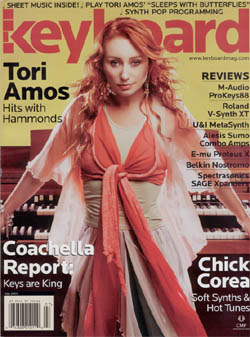
[cover headline]
Tori Amos
Hits with Hammonds
[table of contents]
Tori Amos
Tori Amos is back with a great new CD, The Beekeeper, and she's keeping a couple of B's onstage with her, too (okay, so she plays A-100s, it's close enough). Get the story on how her instruments inspire her songs.
[article]
METAPHYSICS AND MUSIC
With a mage's touch on claviers varied, Tori Amos conjures musical and literary wonders.
by Michael Gallant
photos by Kate Turning and Janell Umemoto
Under the vaulted glass ceiling of Philadelphia's Kimmel Center, the faithful begin to gather hours before showtime. Tori Amos' name adorns the marquee and for many of the piano goddess' fans, the chance to hear a snippet of sound check or to catch sight of their muse at the traditional meet and greet is well worth the stakeout.
Though many Tori enthusiasts follow the pop pianist with Deadhead fervor, the dynamic with which they engage the superstar is unique. Cheers and screams greet her when she walks on stage, but reverent silence falls the moment she strikes her first note. Acid isn't part of the equation, nor is tye-dye or patchouli. The musical power emanating from the lone, diminutive redhead is enough to keep crowds coming back, tour after tour.
Starting with her 1992 debut record Little Earthquakes (Atlantic), Tori has been widely regarded as one of the most innovative, evocative, and downright gutsy songwriters in American popular music, as well as one of its most charismatic performers, piano-focused or otherwise.
Catch her live and you won't be in for your average concert experience. Hinting at both the sanctity of a religious service and the rawness of a rock show, Tori's performances combine disparate elements in a way the artist has long been famous for. And amazingly enough, this time there's no backup band in sight. On the current worldwide "Original Sinsuality" tour, Tori captains a combination piano and vintage keyboard rig and single-handedly leads her congregation as the irreverent prophet, the author and editor of a personal musical gospel.
Not only did her latest recording The Beekeeper (Epic), debut at No. 5 on the Billboard Top 200 Album chart, her new memoir Piece by Piece (published by Broadway Books and co-written with rock journalist Anne Powers) landed comfortably at No. 14 on the New York Times bestseller list. We caught some downtime with Tori at a recent show in Philadelphia to find out more about her twin releases and the work that went into them.

THE COMPOSER AND THE BEEKEEPER
"Great composers are collectors of ideas first," Tori writes in Piece by Piece. "They are able to unite different ideas that might not work on their own but together are complete, a pollination of ideas. This alone was the budding idea that led to my latest project being called The Beekeeper."
On the new disc, an ambitious collection of 19 tracks that runs nearly 80 minutes, Tori's compositional chops make subtle majesty out of tunes like "Parasol," The Beekeeper's captivating opener. From the sparse, introductory two-chord motif, Tori creates an ominous atmosphere in which she tells a story of rising challenges and inner strength. "When I come to terms, to terms with this/my world will change for me," she sings, lyrics melding with her keyboard work to create a chilly sense of foreboding. Through thickening percussion and ringing piano chords, she builds the narrative. "I stare at the wall knowing on the other side/the storm that waits for me," before resolving the tension with the refreshing, major-harmony chorus: "If I'm the seated woman with the Parasol/I will be safe in my frame." That's a literal frame; see "Parasol" on page 28.
Tori applies an equally potent flavor of composition to the understated burlesque blues of "Hoochie Woman," a humorously pointed track that makes excellent use of low-register piano riffs and unconventional percussion. Also impressive is the gospel organ-infused "Witness," a track made all the more booty-shaking by an energetic choir and punchy vocal arrangements.
Enthusiasm, curiosity, experimentation, self-critique, and loads of research come together to make Tori's music what it is. And as eclectic as it may seem, understanding the framework in which she creates is key to understanding the music itself.
THE INSTRUMENTS
More than a simple tool of self-expression or a well-crafted amalgamation of spruce and strings, Tori's beloved Bosendorfer is a multi-faceted companion, in musical journeys and life in general. "I've been able to have a confidence in the spirit of the creature we call the piano," she says. "Over the years, in situations where I have invested time and energy and become disappointed in the outcomes -- in projects, in people, in creativity itself -- the piano has never let me down. The piano has never bailed. The essence itself has always been there to allow me to take chances and to push me in a way.
"It plays me, really," she continues. "I don't play it. There is surrender to what the instrument is capable of and I try and listen to it; really listen to it. Every piano -- the notes, the sound of the relationships is unique." Sitting at the Steinway in her dressing room, she plays a chord. "If I played this on my Bosendorfer, it would be ever so slightly different. And if your ears are open to that, if you're not too deaf from listening to music through the years, it triggers the next answer (plays a variation). You begin to pioneer again every time you're able to really listen to an instrument. Without leaving the room, I feel like I travel into the universe of sound."
According to Tori, the piano can even take on prophetic qualities. "The more changes that happen in the world, the more the consistent changes on the piano show me that the instrument is very much aligned with this deeper knowing. The creative force in instruments seems to be very much in the know and I'm just like Sherlock Holmes, just trying to piece together the clues."
Though she's long made music with non-piano key- board instruments -- she has played various electric axes and even a harpsichord extensively in the past -- The Beekeeper marks Tori's first creative collaboration with the Hammond B-3, an instrument she personifies as the male counterpart to her female Bsendorfer. "A Hammond showed up as a Christmas present a few years ago in the piano room," says Tori. "It was already in the Bosendorfer's space and it seemed very male to me, this organ essence. I began spending time with it, a little more every day and the songs started to develop.
"It seemed like a while," she continues. "A two-year process -- just hearing songs start on the piano, realizing how they could expand." Resulting from this process are pieces like "Sweet the Sting," a vocally-rich rhumba track that seductively grooves on a bed of Hammond harmonies. Though conceptually conceived on piano and sonically born on Hammond, song comes full circle when she plays it live. "I never saw it as an acoustic track," she says. "I saw it very much as a rhythmic piece. So in order to get percussion without bass or kick drum, I play it live on piano."

THE MYTHOLOGY
Complex and cryptic, Tories music carries a rare emotional potency, a richness that comes from the artist's deep emotional engagement with every aspect of her creative process. From lyrics to melodies, instrument choice to set-list selection -- all facets of the piano woman's art are polished and sharpened within the framework of her personal musical mythology. Articulately explored and explained in Piece by Piece, this musical approach is as multi-faceted as the music it informs. Here's a glimpse of the forces at play.
"Tori's music is all about integration," an enthusiastic fan explained to us after the show in Philadelphia. One particularly strong example of this involves two Biblical Marys -- the Virgin and the Magdalene. As Tori writes early in Piece by Piece, one represents the sacred and the other the profane, two polar opposites that seemed to be unnaturally torn from each other and dogmatically incompatible, given the strict Methodist home in which she grew up. The reunion of holiness and sexuality, embodied by a character she calls "the sacred prostitute," represents a powerful archetype she has attempted to construct in her life and embody in her music.
"The piano is the bridge that resolves these elements," Tori writes. "Music has alchemical qualities. And there's more than one voice on the piano. You have two hands. One can be playing a celestial melody while the other is doing quite the opposite. The joining of the profane and the sacred, or the passionate and the compassionate, happens right there on the keyboard. It reconciles a bond severed a long time ago."
Tori captures the essence of this dynamic through both her lyrics and piano work on "Original Sinsuality," a thoughtfully subversive ballad that tells an alternate version of the Garden of Eden story. "Original sin? No, I don't think so," Tori sings, delicately but with determination. "No, it should be original sin-suality."
THE PEN AND THE PIANO
Just like The Beekeeper, Piece by Piece overflows with evidence of the emotional and creative energy invested in its creation. In addition to a revealing biographical account of the artist, the book also features sections on Tori's spiritual musical outlook, creative methodology, perspective on touring, and experiences navigating perils of the music business. It's a quirky read for sure -- even if you happen to be a scholar of Native American spirituality or the New Testament, you're likely to learn something new -- but it's well worth experiencing. Smoothly written and refreshingly honest and thorough. Piece by Piece has much humor, insight, and useful musical wisdom to offer to the casual listener and die-hard fan alike.
We at Keyboard know how the roles of writer and musician can exist symbiotically, but how does the rela- tionship apply to Tori, the long-time rock star and first- time author? Whether she's writing transcendent pop or revelatory prose, jotting down lyrics or constructing a set list, the same emotional and intellectual rigors apply. "I do a lot of research when I'm writing," Tori begins. "But I also write my live shows for the performer; it's not just random songs thrown together. If you're part of Shakespeare's Band of Merry Players -- which as a per- former you want to be -- you're very dependent on the material. The writer in me knows what the performer's able to carry off and what she wants to express. Sometimes, both of them are surprised in each other.
"Not all writers are performers and not all performers, as we know, are writers. I've tried to develop the two over the years independently as well as dependently."
SINSUALITY
Much of Tori's inspiration grows from the union between the sacred and profane, and the eroti- cism that informs her creative process also touch- es the powerful dynamic she shares with her live audiences night after night. Though unfazed by the topic of discussion, Tori takes a long pause before diving into the topic. "If we think of sexuality as insertion between two beings -- say, they're human -- that's one way. Then there's also this idea of union between the song that comes alive and the person that's allowing it to permeate their core, even more deeply than the insertion of a physical act. Now yes, you can take a person into your being, and you can transcend just the act itself; that's when you walk into something that people have been trying to define since we've been able to express ourselves as human beings. But when music is joining with a performer and that performer is able to dance with it, argue with it, be seduced by it, or seduce it," she continues. "To me, this is what the ancient feminine mysteries were really about.
"If I never had a physical relationship again," she emphasizes, "I would be completely sexually satisfied just by playing music. And I'm not just talking about physical response. I'm talking about every chakra. I'm talking about a transcendence, when you're fully aligned with creativity. It doesn't happen all the time, but when it does happen, it usually happens in performance. Because there's something about not being able to repeat yourself, about it being alive, about the dangerous side of performance, about being exposed. And when it's achieved, there's a sense of wholeness. You're not separate from the piece. It's fully integrated within your being."
Though the central sensual interaction in a performance exists between the performer and the song, the audience also plays an important role. "It's another aspect," she says. "Sometimes they're holding space for this interaction to occur. Sometimes they're pushing you to want to react. But the music -- that's the rocket ship that takes you there."
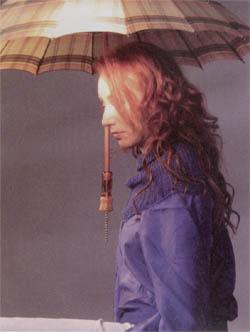
[sidebars]
COMPANIONSHIP
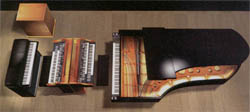
TORI'S ORGAN MALFUNCTIONS
"These Hammonds can get rattled really easily. We had a tech out with us until New York and then he had to go home. He lives in England and he's a family man. As soon as he left our show in Connecticut, the Hammond started crackling and going through its machinations, as it's gonna.
"The great thing about being a piano player is, when all else fails, I move it to the Bosendorfer quick. I look at everybody (in the Sound crew) and they know the signal.. Just back to the Bosendorfer, tried and true,"
INSPIRATIONAL CDS
"The Beatles records that were made during the mid to late '60s, from Sgt. Pepper's Lonely Hearts Club Band to the White Album to Abbey Road were very inspirational, although the first one that really had an impact was the one that had 'Eleanor Rigby' on it. [Revolver] When I heard 'Eleanor Rigby,' as a piano player and as somebody who loved composition and orchestration, I really was moved. I began to talk to people at Peabody [Conservatory in Baltimore, MD, where Tori studied as a child] who didn't want to be concert pianists but believed that there was another option -- the composer option."
(WHY DON'T WE KNOW)
WHAT'S IN TORI'S CD PLAYER?
Thanks to Piece by Piece, we had a sense ahead of time that Tori likes to keep details of her current musical tastes to herself. "It's one of those incredibly personal parts of my process," she explains in person. "As I'm designing set lists and I'm beginning to get ideas, I feel like the live performance is another level of composition. Although the songs are all written, I compose a narrative with these compositions that are finished."
On her current tour, she includes a section called "Tori's Piano Bar" in which she plays covers, some suggested by her fans via the internet. "If I'm listening to something, you might know because of the cover songs," she says. "I'm designing the whole show around a certain feeling tonight and I'm really drawn to play 'Streets of Philadelphia' by Bruce Springsteen. I don't usually do city songs for cities but, for some reason, it's affected me being here [in Philadelphia]."
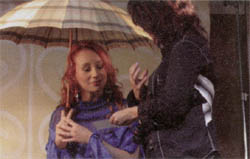
Behind the Scenes
Tori Amos exerts quite an influence, not only through her music, but on those in her immediate vicinity as well. Photographer Kate Turning seemed to bond particularly well with the chanteuse, a fact confirmed by Tori when she said, "I could have tea with you every day." Assistant editor Michael Gallant called the process of exploring Tori's magical world on her own terms, "kind of an anthropological study. Tori is brilliant, and though the way she talks about music may seem alien to many traditional ideas about music, there is a lot of depth in there, and it's very inspiring." As we went through the copyright clearance and approval process for our transcription of "Sleeps with Butterflies," we were not surprised to learn that Tori proofreads all transcriptions of her songs at sight -- she has perfect pitch, and musical scores speak directly to her.
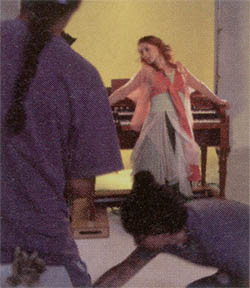
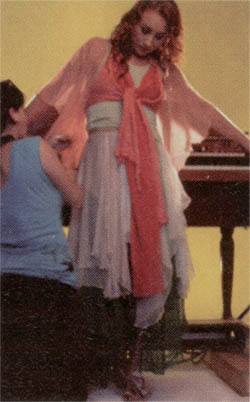
[scans by Richard Handal]
t o r i p h o r i a
tori amos digital archive
yessaid.com
|